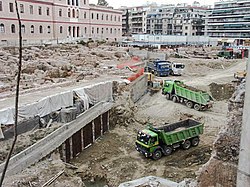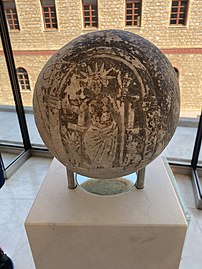Acropolis Museum
| |||||||||||||||||||||||||||||
Read other articles:
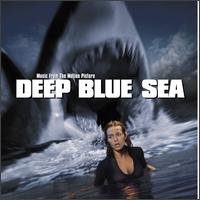
1999 soundtrack album by Various artistsDeep Blue SeaSoundtrack album by Various artistsReleasedJuly 27, 1999Recorded1999GenreHip hop, R&BLength1:45:00LabelWarner Bros. 9 47485-2ProducerVarious artistsSingles from Deep Blue Sea Say WhatReleased: August 3, 1999 Deepest BluestReleased: 1999 Just BecauseReleased: 1999 El Paraiso RicoReleased: 1999 Remote Control SoulReleased: 1999 Professional ratingsReview scoresSourceRatingAllmusic [1] Deep Blue Sea is the soundtrack to the 19…

Un manifesto di Jules Chأ©ret del 1895 Un manifesto أ¨ un foglio di carta stampato che si affigge in un luogo pubblico allo scopo di comunicare qualcosa o fare pubblicitأ . Indice 1 Formato 2 Caratteristiche 3 Bibliografia 4 Voci correlate 5 Altri progetti 6 Collegamenti esterni Formato In Italia la dimensione standard del manifesto أ¨ di 70x100 cm (con multipli o sottomultipli di questa misura). A differenza del poster, che di regola ha un orientamento orizzontale (il lato lungo rappresenta la …
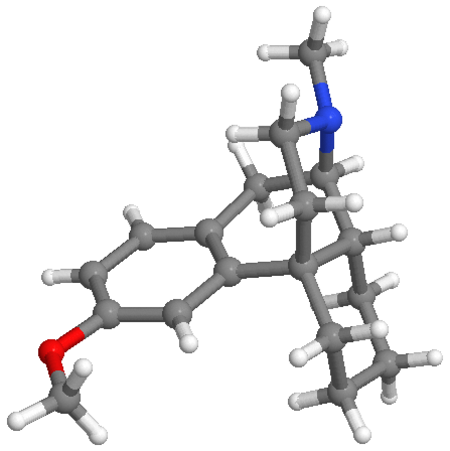
Opioid analgesic Not to be confused with Dextromethorphan, Dextrorphan, or 3-Methoxymorphinan. LevomethorphanClinical dataDependenceliabilityHighAddictionliabilityHighATC codeNoneLegal statusLegal status AU: S9 (Prohibited substance) BR: Class A1 (Narcotic drugs)[1] CA: Schedule I DE: Anlage I (Authorized scientific use only) UK: Class A US: Schedule II Pharmacokinetic dataElimination half-life3-6 hoursIdentifiers IUPAC name (1R,9R,10R)-4-methoxy-17-methyl-1…

American theatrical producer and director For the baseball player of the same name, see Brock Pemberton (baseball). Brock PembertonBrock PembertonBornRalph Brock Pemberton(1885-12-14)December 14, 1885Leavenworth, Kansas, U.S.DiedMarch 11, 1950(1950-03-11) (aged 64)New York City, New York, U.S.EducationUniversity of KansasAlma materCollege of EmporiaOccupationsTheatre producertheatre directorstage actorjournalistKnown forFounding the Tony AwardsNotable workHarveySpouse Margaret McC…

Artikel ini sebatang kara, artinya tidak ada artikel lain yang memiliki pranala balik ke halaman ini.Bantulah menambah pranala ke artikel ini dari artikel yang berhubungan atau coba peralatan pencari pranala.Tag ini diberikan pada Februari 2023. USS America (LHA-6) Sejarah Amerika Serikat Nama America[1]Asal nama Amerika SerikatDihadiahkan 1 Juni 2007Pembangun Huntington Ingalls IndustriesPasang lunas 17 Juli 2009[2]Diluncurkan 4 Juni 2012Sponsor Lynne PaceDibaptis 20 Oktober 201…

Biblioteca nazionale e universitaria della Slovenia(SL) Narodna in univerzitetna knjiإ¾nicaVista dal castello di LubianaUbicazioneStato Slovenia Cittأ Lubiana IndirizzoTurjaإ،ka 1 CaratteristicheISILSI-50001 Numero opere2.749.593[1] ArchitettoJoإ¾e Pleؤچnik Costruzione1936-1941 Sito web Modifica dati su Wikidata آ· ManualeCoordinate: 46آ°02′51″N 14آ°30′12.6″E / 46.0475آ°N 14.5035آ°E46.0475; 14.5035 La biblioteca nazionale e universitaria della Slovenia (…

Motivasi atau dorongan adalah proses yang menjelaskan intensitas, arah, dan ketekunan seorang individu dalam mencapai tujuannya.[1] Tiga elemen utama dalam definisi ini diantaranya adalah intensitas, arah, dan ketekunan.[2] Berdasarkan teori hierarki kebutuhan Abraham Maslow, teori X dan teori Y Douglas McGregor maupun teori motivasi kontemporer, arti motivasi adalah 'alasan' yang mendasari sebuah perbuatan yang dilakukan oleh seorang individu. Seseorang dikatakan memiliki motiva…

†ذ،ر‚ذµذ»ذ»ذµر€ذ¾ذ²ذ° ذ؛ذ¾ر€ذ¾ذ²ذ° ذœرƒذ»رڈذ¶ رپر‚ذµذ»ذ»ذµر€ذ¾ذ²ذ¾ذ¹ ذ؛ذ¾ر€ذ¾ذ²ر‹ ذ² ذ›ذ¾ذ½ذ´ذ¾ذ½رپذ؛ذ¾ذ¼ ذ¼رƒذ·ذµذµ ذµرپر‚ذµرپر‚ذ²ذ¾ذ·ذ½ذ°ذ½ذ¸رڈ ذذ°رƒر‡ذ½ذ°رڈ ذ؛ذ»ذ°رپرپذ¸ر„ذ¸ذ؛ذ°ر†ذ¸رڈ ذ”ذ¾ذ¼ذµذ½:ذرƒذ؛ذ°ر€ذ¸ذ¾ر‚ر‹ذ¦ذ°ر€رپر‚ذ²ذ¾:ذ–ذ¸ذ²ذ¾ر‚ذ½ر‹ذµذںذ¾ذ´ر†ذ°ر€رپر‚ذ²ذ¾:ذرƒذ¼ذµر‚ذ°ذ·ذ¾ذ¸ذ‘ذµذ· ر€ذ°ذ½ذ³ذ°:ذ”ذ²رƒرپر‚ذ¾ر€ذ¾ذ½ذ½ذµ-رپذ¸ذ¼ذ¼ذµر‚ر€ذ¸ر‡ذ½ر‹ذµذ‘ذµذ· ر€ذ°ذ½ذ³ذ°:ذ’ر‚ذ¾ر€ذ¸ر‡ذ½ذ¾ر€ذ¾ر‚ر‹ذµذ¢ذ¸ذ؟:ذ¥ذ¾ر€ذ´ذ¾ذ²ر‹ذµذںذ¾ذ´ر‚ذ¸ذ؟:ذںذ¾ذ·ذ²ذ¾ذ½ذ¾ر‡ذ½ر‹ذµذکذ½ر„ر€ذ°ر‚ذ¸ذ؟:ذ§ذµذ»رژرپر‚ذ½ذ¾ر€ذ¾ر…

This article needs additional citations for verification. Please help improve this article by adding citations to reliable sources. Unsourced material may be challenged and removed.Find sources: Quadruple reed – news آ· newspapers آ· books آ· scholar آ· JSTOR (December 2009) (Learn how and when to remove this message) Bassoon double reeds: note the elliptical (oval) opening (bottom left) Shehnai Cambodian sralai instruments. At left the srali thom (thom means…

First Lady of BulgariaCoat of arms of BulgariaIncumbentDesislava Radeva[1]since 22 January 2017ResidenceLargo, SofiaTerm lengthConcurrent with the president's term (unless a divorce or death takes place)Inaugural holderMariya ZhelevaFormation17 November 1989 First Lady of Bulgaria (Bulgarian: ذںرٹر€ذ²ذ° ذ´ذ°ذ¼ذ° ذ½ذ° ذ‘رٹذ»ذ³ذ°ر€ذ¸رڈ, romanized: Parva dama na Balgariya) is an unofficial honorific applied to the wife of the president of Bulgaria. Officially, her term as first la…
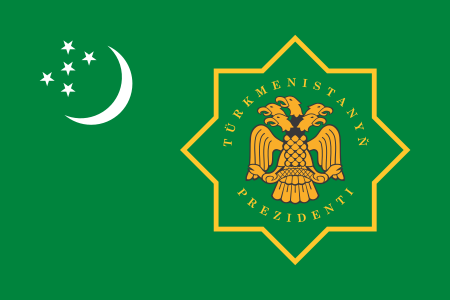
هœںه؛“و›¼و–¯ه¦و€»ç»ںهœںه؛“و›¼و–¯ه¦ه›½ه¾½هœںه؛“و›¼و–¯ه¦و€»ç»ںو——çڈ¾ن»»è°¢ه°”è¾¾ه°”آ·هˆ«ه°”ه¾·ç©†ه“ˆو¢…ه¤ڑه¤«è‡ھ2022ه¹´3وœˆ19و—¥ه®ک邸éک؟ن»€ه“ˆه·´ه¾·و€»ç»ںه؛œï¼ˆOguzkhan Presidential Palace)و©ںé—œو‰€هœ¨هœ°éک؟ن»€ه“ˆه·´ه¾·ن»»ه‘½è€…ç›´وژ¥é€‰ن¸¾ن»»وœں7ه¹´ï¼Œهڈ¯è؟选è؟ن»»é¦–ن»»èگ¨ه¸•ه°”穆و‹‰ç‰¹آ·ه°¼ن؛ڑن½گه¤«è®¾ç«‹1991ه¹´10وœˆ27و—¥ هœںه؛“و›¼و–¯ه¦هœںه؛“و›¼و–¯ه¦و”؟ه؛œن¸ژو”؟و²» ه›½ه®¶و”؟ه؛œ هœںه؛“و›¼و–¯ه¦ه®ھو³• ه›½و—— ه›½ه¾½ ه›½وŒ ç«‹و³•و©ں關(英è¯ï¼ڑNational Council of Turkmenistan) هœںه…

Black mixture of copper, silver, and lead sulphides For other uses, see Niello (disambiguation). Diptych with Nativity and Adoration, silver and niello, gilt-bronze frame, Paris, c. 1500, The Cloisters Byzantine gold ring with niello inscription Lord help Leontius, Patrician and Count of imperial Obsikion guarded by God, c. 1000 AD Niello /niثگثˆة›loتٹ/[1][2] is a black mixture, usually of sulphur, copper, silver, and lead,[3] used as an inlay on engraved or etched …

Overview of genocides from 1945 For broader coverage of this topic, see Genocides in history, Genocides in history (before World War I), Genocides in history (World War I through World War II), and Genocides in history (21st century). Part of a series onGenocide Issues List of genocides Genocides in history Effects on youth Denial Massacre Rape Incitement In relation to Colonialism / War Perpetrators, victims, and bystanders Prevention Psychology Recognition politics Risk factors Stages…

Untuk kegunaan lain, lihat Fuwa (disambiguasi). Maskot Olimpiade Beijing 2008: Fuwa Fuwa (ç¦ڈه¨ƒ Fأ؛wأ،, Indo:Boneka Keberuntungan, Ing:Friendlies) adalah maskot dari Olimpiade Musim Panas 2008. Dalam Bahasa Inggris, Friendlies (jamak dari friendly) berarti bersahabat atau ramah. Maskot ini diumumkan oleh Perkumpulan Nasional Ilmu Kesusasteraan Klasik Tiongkok pada 11 November, 2005 pada sebuah acara memperingati hari keseribu sebelum pembukaan Olimpiade. Fuwa terdiri atas 5 anggota: Beibei, Jin…

ظٹظپطھظ‚ط± ظ…ططھظˆظ‰ ظ‡ط°ظ‡ ط§ظ„ظ…ظ‚ط§ظ„ط© ط¥ظ„ظ‰ ط§ظ„ط§ط³طھط´ظ‡ط§ط¯ ط¨ظ…طµط§ط¯ط±. ظپط¶ظ„ط§ظ‹طŒ ط³ط§ظ‡ظ… ظپظٹ طھط·ظˆظٹط± ظ‡ط°ظ‡ ط§ظ„ظ…ظ‚ط§ظ„ط© ظ…ظ† ط®ظ„ط§ظ„ ط¥ط¶ط§ظپط© ظ…طµط§ط¯ط± ظ…ظˆط«ظˆظ‚ ط¨ظ‡ط§. ط£ظٹ ظ…ط¹ظ„ظˆظ…ط§طھ ط؛ظٹط± ظ…ظˆط«ظ‚ط© ظٹظ…ظƒظ† ط§ظ„طھط´ظƒظٹظƒ ط¨ظ‡ط§ ظˆط¥ط²ط§ظ„طھظ‡ط§. (ط¯ظٹط³ظ…ط¨ط± 2018) ط§ظ„طط¬ظ… ط¹ظ„ظ‰ ط§ظ„ظٹط³ط§ط± ط§ظ„ط¨ط¹ط¯ ظˆط§ظ„ط£ط³ظ…ط§ط، ط¹ظ„ظ‰ ط§ظ„ظٹظ…ظٹظ† ظ„ط¨ط¹ط¶ ظ…ظ† ط£ط´ظ‡ط± ط§ظ„ظ…ط¬ط±ط§طھ ظ„ظ„ظ…ظ‚ط§ط±ظ†ط©. ظ‚ط§ط¦ظ…ط© ط§ظ„ظ…ط¬ط±ط§طھ ظ‚ظˆط§ط¦ظ… ط§ظ„ظ…ط¬ط±ط§طھ ظ‚ط§ط¦ظ…

Tramway system serving Montpellier This article needs to be updated. Please help update this article to reflect recent events or newly available information. (September 2012) Montpellier tramwayAlstom Citadis 401 of Line 1OverviewNative nameTramway de MontpellierLocaleMontpellier, Occitanie, FranceTransit typeTramNumber of lines4Number of stations84Daily ridership282,000 (2012)Annual ridership66.32 million (2018)[1]OperationBegan operation1 July 2000[1]Operator(s)TAMTechnicalSyst…

List of events in the year 1354 ← 1353 1352 1351 1350 1349 1354 in Ireland → 1355 1356 1357 1358 1359 Centuries: 12th 13th 14th 15th 16th Decades: 1330s 1340s 1350s 1360s 1370s See also:Other events of 1354 List of years in Ireland Events from the year 1354 in Ireland. Incumbent Lord: Edward III Events This section is empty. You can help by adding to it. (February 2015) Births Deaths Edmund de Grimsby, an English cleric, Crown official and judge. While his career in Ireland lasted on…

وڈگç¤؛ï¼ڑو¤و،ç›®é،µçڑ„ن¸»é¢کن¸چوک¯èگ§م€‚ ç°«çگ´ç°«èˆ‡و´ç°«وœ¨ç®،و¨‚ه™¨و¨‚ه™¨هˆ¥هگچè±ژهگ¹م€پè±ژ篴م€پé€ڑو´هˆ†é،ç®،و¨‚ه™¨ç›¸é—œو¨‚ه™¨ ه°؛ه…« ن¸œو±‰و—¶وœںçڑ„陶هˆ¶ç®«ه¥ڈ者ن؛؛هƒڈ,ه‡؛هœںو–¼ه½ه±±و±ںهڈ£و±‰ه´–ه¢“,è—ڈو–¼هچ—ن؛¬هچڑ物院 箫هڈˆç¨±و´ç°«م€پç°«ç®،,وک¯ن¸هœ‹هڈ¤è€پçڑ„هگ¹ç®،و¨‚ه™¨ï¼Œç‰¹ه¾µç‚؛ه–®ç®،م€پè±ژهگ¹م€پé–‹ç®،م€پé‚ٹ稜éں³ç™¼èپ²[1]م€‚م€Œç°«م€چه—هœ¨ه”گن»£ن»¥ه‰چوœ¬وŒ‡وژ’簫,ه”گه®‹ن»¥ن¾†ï¼Œç”±و–¼ه–®ç®،è±ژهگ¹çڑ„ç°«و—¥و¼¸وµپè،Œï¼Œن¾؟稱編ç®،簫爲وژ’簫,ن»…

American nonprofit organization NRA redirects here. For other uses, see NRA (disambiguation) and National Rifle Association (disambiguation). National Rifle Association of AmericaFoundedNovember 17, 1871;152 years ago (1871-11-17)FounderWilliam Conant ChurchGeorge Wood WingateFounded atNew York CityType501(c)(4)[1]Tax ID no. 53-0116130FocusGun politicsGun rightsLocationFairfax County, Virginia, U.S. 38آ°51′47″N 77آ°20′8″W / 38.86306آ°N 77.33556آ°W&#x…

One of the 234 State Legislative Assembly Constituencies in Tamil Nadu, in India 9آ°58′N 77آ°48′E / 9.97آ°N 77.8آ°E / 9.97; 77.8 UsilampattiConstituency No. 197 for the Tamil Nadu Legislative AssemblyConstituency detailsCountryIndiaRegionSouth IndiaStateTamil NaduTotal electors2,84,585[1]Member of Legislative Assembly16th Tamil Nadu Legislative AssemblyIncumbent P. Ayyappan Party IndependentElected year2021 Usilampatti is a state assembly constituen…




